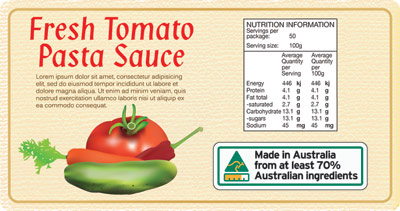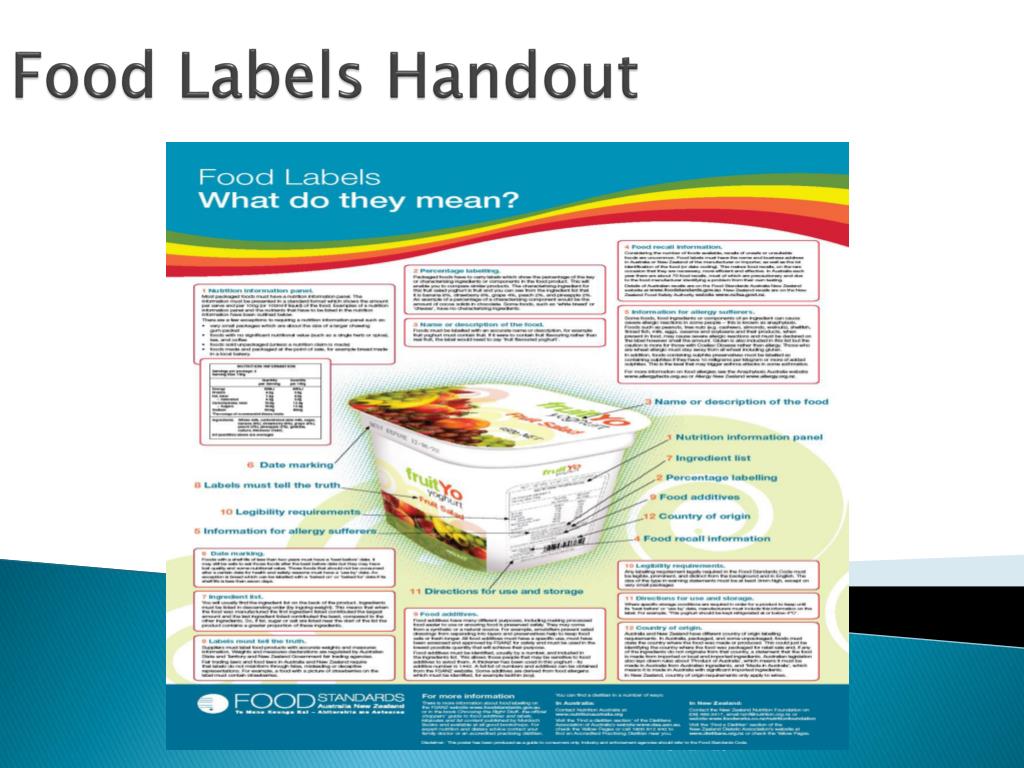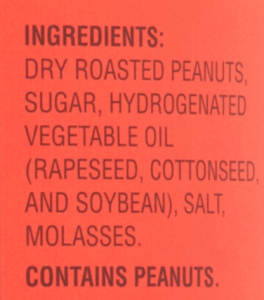40 is country of origin required on food labels
Country of origin | ACCC When a food has not been grown, produced or made in a single country, it will need to display a label identifying the country it was packed in. Priority and non-priority foods. Non-priority foods must carry a country of origin text statement about where the food was grown, produced, made or packed. A product is a non-priority food if it belongs to one of the following categories: A Brief History and Overview of Country of Origin Labeling Requirements ... Country of Origin Labeling (COOL) laws and regulations require retailers to notify their customers of the country of origin of covered commodities, which include beef, veal, lamb, chicken, fish and shellfish, goat, pork, perishable agricultural commodities, macadamia nuts, pecans, ginseng, and peanuts.
eCFR :: 19 CFR Part 134 -- Country of Origin Marking Any intentional removal, defacement, destruction, or alteration of a marking of the country of origin required by section 304, Tariff Act of 1930, as amended (19 U.S.C. 1304), and this part in order to conceal this information may result in criminal penalties of up to $5,000 and/or imprisonment for 1 year, as provided in 19 U.S.C. 1304(h).

Is country of origin required on food labels
Country of Origin Labeling (COOL) Frequently Asked Questions Country of Origin Labeling (COOL) is a consumer labeling law that requires retailers (most grocery stores and supermarkets) to identify the country of origin on certain foods referred to as "covered commodities". The 2002 and 2008 Farm Bills and the 2016 Consolidated Appropriations Act amended the Agricultural Marketing Act of 1946 to require retailers to notify their customers of the country of origin of muscle cuts and ground lamb, chicken, goat, wild and farm-raised fish and shellfish Marking of Country of Origin on U.S. Imports Marking of Containers . Usual containers imported filled must be marked with the name of the country of origin of the contents of the usual container, unless the contents are marked with the country of origin and the usual containers can be readily opened for inspection of the contents. Origin Labeling Requirements for Imported Commodities Passed Tuesday, June 15, 2021 We have previously reported on proposed Senate legislation that would require country of origin labeling (COOL) for imported commodities sold online. On June 8, 2021, the...
Is country of origin required on food labels. Must processed food products have a country of origin label? Must processed food products have a country of origin label? Jul 17, 2019 Knowledge Article Retail items that meet the definition of a processed food item do not require labeling under the COOL final rule. For more information, visit Common Questions & Answers on Country of Origin Labeling. Country of origin labelling - Food Standards Country of origin labelling requirements for food is in the Country of Origin Food Labelling Information Standard 2016, under the Competition and Consumer Act 2010. These requirements became mandatory on 1 July 2018. At the same time, the Food Standards Code was amended to remove country of origin labelling requirements. How to Navigate the Country of Origin Food Labelling Requirements — Lau ... First step: Utilise the Department of Industry, Innovation and Science's online decision tool to ascertain whether you need to display a country of origin label on your products. Next step: Where the proportional Australian content must be displayed, ensure accurate calculation and display requirements. Final step: Ensure the compliance date ... Country of Origin Food Labeling | Jenn David Design The Country of Origin Labeling requirement states that "Food labeling statements regarding geographical origin must not be false or misleading in any particular.". So it would be incorrect to state that the cocoa is a product of both Mexico and Chile on the label. You would need two labels in this case—one for each respective country of ...
Country-of-Origin Labeling for Foods and the WTO Trade ... - Congress Country-of-Origin Labeling for Foods and the WTO Trade Dispute on Meat Labeling Congressional Research Service Summary Since the final rule to implement country-of-origin labeling (COOL) took effect in March 2009, most retail food stores have been required to inform consumers about the country of origin of Commerce Commission - Country of origin of food on the food item; on packaging; on signage located next to the food item; in a similar way. When a regulated food item is offered or advertised then the Regulations require that the origin information be disclosed as part of the offer or advertisement. The key point is that there must be a clear connection between the disclosure and the food item. Country of origin on food labels - Canadian Food Inspection Agency Country of origin on food labels. In Canada, there are mandatory requirements for certain food products to indicate the foreign state (definition) of origin on their labels. Although foreign states include countries as well as World Trade Organization (WTO) members, the Industry Labelling Tool commonly refers to this requirement as country of origin labelling. CPG Sec. 560.200 Country of Origin Labeling - Food and Drug Administration A statement of the country of origin on the labeling of imported foods is not required by the Federal Food, Drug, & Cosmetic Act. This is a requirement of the U.S. Customs *and Border Protection...
Mandatory country-of-origin labeling (US) - Wikipedia Country of origin labeling (COOL) (or mCOOL [ m for mandatory]) is a requirement signed into American law under Title X of the Farm Security and Rural Investment Act of 2002 (also known as the 2002 Farm Bill), codified at 7 U.S.C. § 1638a as Notice of country of origin. Origin labelling - Food Safety In accordance with Regulation (EU) No 1169/2011, the general rule is that the indication of the country of origin or place of provenance shall be mandatory where failure to indicate this might mislead the consumer as to the true country of origin or place of provenance of the food, in particular if the information accompanying the food or the label as a whole would otherwise imply that the food has a different country of origin or place of provenance.(Article 26(2)(a)). Packaging, Labeling, Transporting, Storing — Food Law Indirect food additives (e.g., packaging) may be only used under conditions of good manufacturing practice; that is, the quantity 1) does not exceed the amount reasonably required to accomplish the intended effect in the food, 2) shall not exceed any prescribed limitations, 3) shall not be intended to accomplish any physical or technical effect ... Country of Origin Labeling of Agricultural Products Rules, Examples, Requirements, Recordkeeping More consumers are checking product and food labels after recent imported product issues and continued health education and awareness campaigns. This growing consumer interest along with other food production issues prompted the federal government to devise laws requiring suppliers to state the origin of specific covered commodities.
Country-of-Origin Labeling for Foods - Homeland Security Digital Library require country-of-origin information to be provided to consumers. The 111th Congress is considering legislation that would expand COOL labeling requirements to cover more food products. H.R. 2749, the House-passed food safety bill, would expand such labeling to apply to all processed foods and to other agricultural commodities not now covered by
Country of Origin Labeling (COOL) | Agricultural Marketing Service Country of Origin Labeling (COOL) is a labeling law that requires retailers, such as full-line grocery stores, supermarkets and club warehouse stores, to notify their customers with information regarding the source of certain foods. Food products covered by the law include muscle cut and ground meats: lamb, goat, and chicken; wild and farm-raised fish and shellfish; fresh and frozen fruits and vegetables; peanuts, pecans, and macadamia nuts; and ginseng.
Country of origin of food - Ministry of Business, Innovation and Employment On 10 May 2021 the Consumer Information Standards (Origin of Food) Regulations 2021 (the Regulations) were made under the Fair Trading Act 1986. These Regulations give effect to the requirements in the Act by setting the detailed country of origin labelling requirements. The Regulations were due to commence on 12 November 2021.
Country of origin food labels | Department of Industry, Science, Energy ... The current requirements for country of origin labelling for food came into full-effect in July 2018. We reviewed the reforms in 2021. The review examined how well the reforms: improved consumer access to information about the origin of food. clarified the origin claims businesses can make about their products.

New changes to Country of Origin Food Labelling, taking place throughout Australia | SBS Your ...
Marking of Country of Origin on U.S. Imports | U.S. Customs ... Aug 12, 2020 · For a good from a NAFTA country: if under the NAFTA Marking Rules (19 CFR Part 102) the second country is determined to be the country of origin of the good; or For an article considered to be a textile or apparel product (regardless of whether it is a good from a NAFTA country): if the country of origin is determined by the general rules set ...
Country of Origin Requirements in the United States: An Overview Country of origin labeling is mandatory for all consumer products imported and sold in the United States. Country of origin labeling is often as straightforward as printing a 'Made in [INSERT COUNTRY]' on the product and its packaging.
What Is Country of Origin Labeling? An Overview According to CBP, the rules of origin contained in 19 CFR Part 102 determine the country of origin for marking purposes of a good imported from Canada or Mexico in accordance with the requirements of 19 CFR Part 134. The product-specific rules of origin contained in GN 11(o) determine whether a good qualifies as originating under the USMCA.
Country of origin food labelling | business.gov.au Country of origin labelling is not required on the following food products: foods not for human consumption (for example, pet food) foods sold in restaurants, cafes, take-away shops or schools. foods sold at fundraisers. foods sold from the same premises in which they have been made and packed.
All About Labels - Country of Origin Food Labeling Country of Origin Food Labeling . Food labeling in Australia is changing. If you sell food in retail stores in Australia your products will be required to display the new labels from 1 st July 2016. You have 2 years to transition to this new labeling system and here at All About Labels we are prepared for our customers to help implement these changes.
Which foods are covered in the country of origin labeling law? - USDA Foods that must be labeled with their country of origin are: 1. Muscle cuts of beef (including veal), lamb, pork, goat, and chicken; 2. Ground beef, ground lamb, ground pork, ground goat, and ground chicken; 3. Wild and farm-raised fish and shellfish; 4. Perishable agricultural commodities (fresh and frozen fruits and vegetables); 5.
Country of origin food labelling | ACCC - Australian Competition and ... Country of origin food labelling If you sell or supply food for retail sale in stores, markets, online or from vending machines it is likely that you will be required to comply with the Country of Origin Food Labelling Information Standard 2016 (Standard). Types of food covered by the standard Label requirements The labels
MDARD - Country of Origin Labeling: What Businesses Need to Know - Michigan In January 2009, the U.S. Department of Agriculture (USDA) announced details of the final regulation for the mandatory country of origin labeling (COOL) program required by the 2002 and 2008 farm bills, and published the full text of the final rule in the Federal Register. The rule took effective on March 16, 2009.
Food labelling: country of origin - GOV.UK You must label your meat, fish or seafood product with its country or place of origin if you're selling it to the final consumer or mass caterer. A catering establishment is a place where food is...
Origin Labeling Requirements for Imported Commodities Passed Tuesday, June 15, 2021 We have previously reported on proposed Senate legislation that would require country of origin labeling (COOL) for imported commodities sold online. On June 8, 2021, the...
Marking of Country of Origin on U.S. Imports Marking of Containers . Usual containers imported filled must be marked with the name of the country of origin of the contents of the usual container, unless the contents are marked with the country of origin and the usual containers can be readily opened for inspection of the contents.








/arc-anglerfish-tgam-prod-tgam.s3.amazonaws.com/public/C6KP5YSHXVHYVMFK6ZG6RTC2CI)


Post a Comment for "40 is country of origin required on food labels"